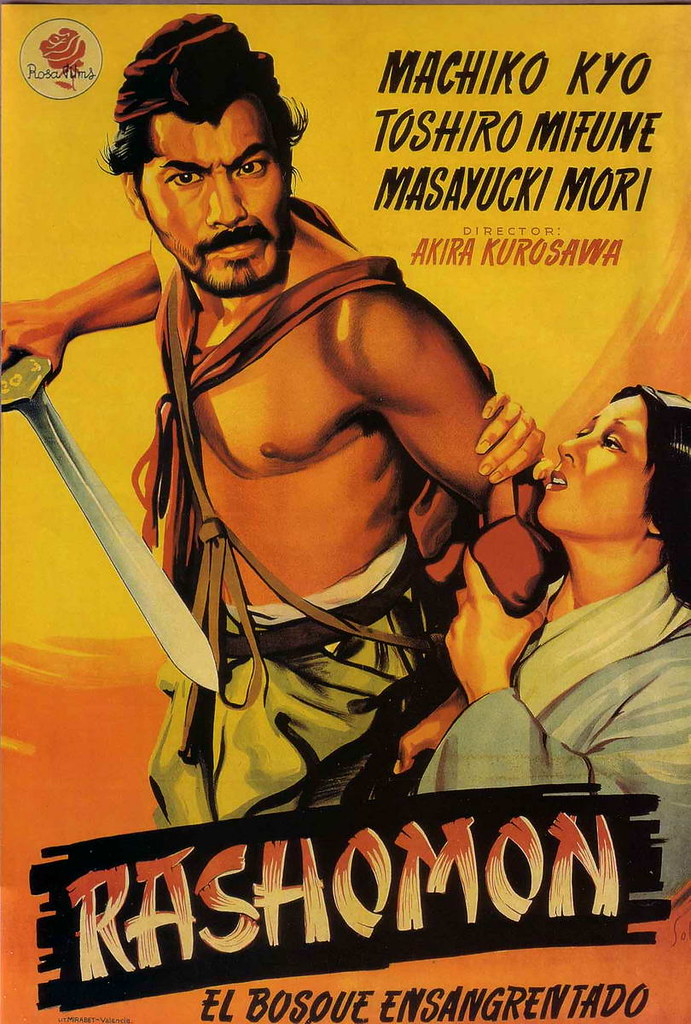
I've been reading about Kurosawa all week, so it was only a matter of time before I started watching his films again. Amazing that this has been my first complete Kurosawa film all year. Obviously the story here is pretty well known, but it was a joy to think about this untraditional narrative from a script standpoint and not just what it means in a grand sense. The order of the events, the details of each lie, fall in a precise order to maximize suspense. In each telling, for example, we know that the samurai is killed, but with each telling the how and why is drawn out with several twists along the way. In the medium's (the samurai's own) telling it appears that Tajomaru is going to kill him at the behest of the cruel, taunting wife, but Tajomaru (in that telling) proves honorable, offering to kill the wicked wife if the samurai just gives the word. In the woodcutter's telling, the protacted amateur sword fight between the two men leaves Tajomaru swordless and the samurai still armed, leaving us to wonder how possibly the tables will turn; followed by the samurai's sword being lodged in a tree trunk at a precarious angle (blade out), teasing the audience that it might even be purely an accident that befalls him. Plus, some details conveniently match up, like Tajomaru's chucking his sword into the bushes to kill the samurai, which occurs both in Tajomaru's own and the woodcutter's versions.
Moreover, it's smart of the story to have each suspect accuse themselves -- confess essentially -- of/to the same crime. Had the wife accused Tajomaru, or Tajomaru claimed the samurai had committed suicide, it would have looked like self-preservation, the most obvious (and understandable) kind of lie there is. Instead we are left to wonder why any of the three would lie to take responsibility. Fortunately the characters are developed enough that we can infer at least possible motives (Tajomaru for the glory, for his pride and reputation; the wife to save face and/or as an expression of her guilt and shame for any collusion, implicit or explicit; and the samurai to save his wife's neck and/or out of shame for his own desire in the moment to do so).
The story is famous for not telling you what happens, and it's difficult to not want to work out some kind of mental graph, a sudoku puzzle of which parts are true and which lies and get to the bottom of this. I'm reasonably sure there is no such solution. But where a lot of scholars and film historians (that is to say, bloggers I've been reading lately) seem to claim that the story's contribution to cinema is to trick us, to leave us back where we started and to prove that no answer is possible, I think Kurosawa may have been a little more holistic than that. I think the answer here is that everybody's right, to a degree, and that truth isn't the same as fact. I like to look at this and not see three or four liars, but three or four imperfect, self-aggrandizing interpretations. Everybody is looking at what happened and telling you the version they want to be true, partially as a series of conscious selections (lies) and partially as a simply skewed set of memories (misremembering), because that's the way everyone's memories are. Memory is hardly infallible, and memory is the primary source of knowledge, especially in this particular story. Therefore, what chance does knowledge have? Truth is barely even a reflection of fact -- more like its echo. A dim, distorted impression that once bounced against actual fact, but that's it.
Okay I got kind of esoteric there. I have been watching Bergman and Kurosawa, after all. What do you expect?

No comments:
Post a Comment